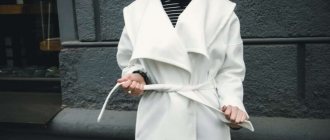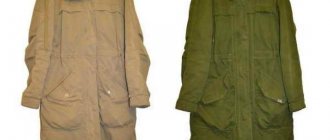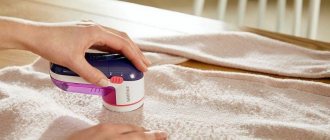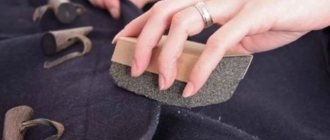A drape coat will never go out of fashion, because it is such a practical and comfortable product that effectively protects from cold and wind. In addition, such outerwear looks very stylish and elegant. The drape is a heavy woolen fabric sewn in two layers.
As a rule, it is not recommended to wash wool coats. Therefore, to clean the material, dry methods are used. In this article we will look at how to clean a drape coat at home.
Before cleaning, carefully inspect the product in a bright place. Hang your coat on hangers and straighten it out. Check the lining and problem areas such as the collar, cuffs and pockets for dirt and stains.
Light dirt, threads, pellets, and lint can be removed with a regular dry brush with soft natural bristles. Clean the coat in the direction of the pile. Then you can go over the material with a slightly damp brush. If the contamination is more serious, other dry cleaning methods are used. Next, we offer tips on how to clean a drape coat without washing.
Features of cleaning a drape coat
Due to the fact that the drape is a two-layer woolen fabric, the use of classic washing is not recommended. The material will simply shrink and the item will deteriorate. The exception is products containing a sufficient amount of artificial fibers. As a rule, information about this can be found on the label. Therefore, all that remains is to take the coat to a professional dry cleaning establishment. You can also try to perform the cleaning procedure yourself, taking precautions.
To clean a drape coat without washing and preserve its external and functional characteristics, you must consider the following recommendations:
- Carefully read the information on the label. It must indicate acceptable cleaning and maintenance methods.
- Inspect the coat, first hanging it by the shoulders, for dirt in vulnerable places - on the collar, sleeves, cuffs.
- Test the effect of the cleaning agent on an inconspicuous part of the coat. If the recipe turns out to be harmful, this will avoid damage to the product.
- When cleaning, dirt should be removed from the drape material strictly in the direction from the center to the periphery. This will get rid of stains and streaks.
- You can prevent your coat from getting wet during wet cleaning by placing moisture-absorbing material under its lining.
- It is best to get rid of minor dirt in the form of small stains, lint, threads using a soft brush for gentle fabric.
- To clean the coat from heavy dirt, you must first use a dry brush, and then a damp brush with rounded bristles.
Regardless of the chosen technique and method, it is permissible to clean drapery material only by the pile.
Hand wash at home
Washing a drape coat by hand should be done if there is a special indication on the product label.
You can wash a drape product by hand, following the following recommendations:
It is necessary to fill a bathtub or large basin with water (temperature 30-40 degrees).- Then add liquid laundry detergent to the water.
- If there is heavy soiling, the coat should be soaked in this water for about 30 minutes and only then proceed directly to the cleansing process.
If the coat just needs to be refreshed, then there is no need to soak the product. - Washing should be done with gentle movements, perhaps using a special brush.
- Rinse the product in cold water until the detergent is completely washed away.
- You should not spin; it is necessary that all the water drains out on its own. An alternative option is to wrap the coat in fabric that absorbs liquid well, and only then proceed to dry the product.
- Dry your drape coat in a vertical position, preferably in a well-ventilated area (for example, on a balcony).
It is impossible to rub the fabric intensively during washing, as this will lead to the appearance of pills and damage to the appearance of the product.
How to clean
Depending on the chosen method and method, cleaning a drape coat from dirt at home is carried out using the following means:
- Brush.
- Sticky roller.
- Bread crumb.
- Powder for cleaning carpets, air conditioners or regular laundry detergent.
- Sponge.
- Table salt with ammonia.
- A solution of laundry or liquid soap.
- Cotton wool.
- Water.
To clean the surface of a drape coat from wool, you need to brush the material in the direction of the pile with a slightly moistened brush. Upon completion of the procedure, the product should be hung in a draft to dry.
Subtleties of cleaning sleeves and collars
The sleeves and collar tend to become shiny when the coat is worn for a long time. If the stains are not too large, you can use brown bread crumbs. They need to rub the shiny areas, giving them their original appearance.
For more extensive abrasions, use a mixture of table salt and ammonia in a ratio of 1:4. Using a swab or soft sponge soaked in a solution, remove shiny stains with intense movements.
Important! Before using such a cleaning composition, you should test its effect on a small, inconspicuous area of the coat. If the material does not change color under the influence of aggressive substances, you can begin cleaning.
How to clean
A drape coat can be cleaned using a quick dry method or a more time-consuming and labor-intensive wet method. Which one to use in a particular situation depends on the degree and nature of the contamination, as well as the availability of free time and the availability of cleaning products. Let's look at each of them in detail.
Dry cleaning
Before starting cleaning, you should prepare all the products and materials used, as well as perform a number of preliminary procedures:
Hang the coat on hangers in a well-lit place and identify the dirtiest places on the drape material.
Using a textile roller and a brush with natural bristles, clean its surface from wool, dust and lint.
Cleaning a drape coat with light contamination is carried out according to the following algorithm:
- Cover the contaminated area of the coat laid out on a horizontal surface evenly with dry washing powder for woolen items.
- Next, rub it over the surface with gloved hands.
- An hour later, remove the powder with a brush with elastic bristles.
- Wipe with a damp sponge and let dry.
For a white or light-colored coat, it is recommended to use the following technique:
- Cover the contaminated area with Vanish or baking soda.
- After half an hour, remove the bleach with a dry brush.
For a drape coat of black or other rich color, it is allowed to use prepared foam for cleaning carpets or air conditioners. In addition, you can use rye bread crumb by crumbling it onto the drape material and then rolling it back up.
The collar of a drape coat, as well as the cuff and pocket areas, are the most difficult to clean. Therefore, it is better to use a solution of table salt in ammonia (1:4). The dirt should be wiped off with a cotton swab dipped in this product.
Wet cleaning
A more effective method compared to the one discussed above is wet cleaning. However, it is recommended to use it no more than once a season. Processing instructions boil down to the following steps:
- Prepare a working solution of one of the cleaning products in warm water - for washing woolen products, laundry or liquid soap, conditioner, liquid for suede.
- Apply evenly and lightly rub the product onto the contaminated area of the coat using a cloth.
- After 30 minutes, rinse the surface with warm water and blot with moisture-absorbing material.
A hydrogen peroxide solution (1:4) can effectively get rid of grease and alcohol stains on the surface of a white and light-colored drape coat. A little product should be poured onto the contaminated area, and then quickly brushed with a rag or brush.
How to wash a drape coat in an automatic machine
How to Clean a Faux Fabric Coat
Polyester coat
Polyester is a special type of synthetic fabric made from polyester fibers. It wrinkles little, retains its shape well and is easy to wash.
- Dust can be removed with a brush or simply by thoroughly shaking the coat.
- To remove stains, use a stain remover (check the reaction on a small area of fabric first).
- Treat difficult stains with table salt: sprinkle on the stains, and after half an hour, wash off with soapy water.
- Remove the most stubborn stains using a 10% borax solution: apply it to the coat, then wipe the stain with lemon juice, and then remove the residue with a damp cloth.
- The coat can be washed by hand in water no hotter than 30°C, without twisting or creasing the fabric.
- Wash polyester in the washing machine with a mild detergent. Choose a delicate or synthetic mode.
- Do not wash polyester in hot water or use bleach as this will damage the fabric.
Drying and care rules
After cleaning, especially wet, the drape coat must be dried, observing the following precautions:
- Hang on hangers in a dry and well-ventilated area.
- To speed up the drying process, the drape fabric should be “blotted” with moisture-absorbing material.
- Direct exposure to solar radiation and heating devices is unacceptable.
A drape coat can be ironed taking into account the following nuances:
- The working surface of the iron should not exceed 200 °C, and the vertical steam function should be present.
- An ironing board can only be used when ironing is done from the inside out.
- For the front side, it is permissible to iron only through damp gauze and in extreme cases.
- Before starting the procedure, it is necessary to check its effect on the fabric from the reverse side of the product.
It is quite acceptable to clean a drape coat at home. To do this, it is necessary to take into account all the features of the procedure, as well as choose the right method - dry or wet. The first is used as needed, the second – once a season. In this case, you need to take into account the nature and area of contamination, the availability of cleaning products and free time.
In what cases should you contact a dry cleaner?
The best way, of course, to solve the problem of contamination of a drape coat is dry cleaning. At home, it is almost impossible to provide the same level of fabric cleaning as can be achieved with expensive professional equipment. At the same time, you can deal with most contaminants yourself, avoiding additional expenses. However, in some situations it makes sense to immediately contact the dry cleaner.
- Unless otherwise indicated on the label.
- You're not sure you can handle this on your own.
- If the coat is snow-white. It's better not to take risks.
- If you managed to stain something with fuel oil. This type of stain is difficult to remove on your own.
- Well, if your efforts at home are unsuccessful.
By the way, you can save a lot if you have your item dry-cleaned during the off-season. For a drape coat, this is, first of all, summer. At this time, the discount on dry cleaning services for such items can reach 50%. But do not put it off under any circumstances when it comes to removing stains - even dry cleaning may not be able to cope with an old, ingrained stain.
Why does my collar get dirty?
This part of the coat often comes into contact with the skin of the neck - a place that is replete with sebaceous and sweat glands. In cases of heavy physical activity, being in a warm room, or simply from excitement, these glands secrete secretions, as a result of which the collar gets dirty. If a piece of clothing is not put in order and refreshed in time, the coat will lose its decent appearance.
The second cause of pollution is the action of cosmetics. Stains from powder, foundation, and lipstick inevitably appear on the collars of women's coats. True, ladies most often protect this detail with scarves, which take the “blow” of the dirt upon themselves. Scarves are easy to wash and use again.
Materials on the topic: ways to wash faux fur at home.
Types of cleaning outerwear
Ways to clean a coat at home:
- Washing (manual or automatic). It is used when the label contains the appropriate marking indicating the recommended water temperature.
- Dry cleaning. This is done with a soft brush, rollers with sticky tear-off sheets, and dust-absorbing sprays (Spot Remover, K2r, Dryel).
- Wet cleaning. It involves treating the product with steam, cleaning individual stains with aqueous solutions with the addition of soap, fabric softener, and stain remover.
Cleaning coats at home is not always effective. Circumstances under which you should contact a dry cleaner:
- marking on the label about the inadmissibility of manual or automatic washing;
- old fuel oil stains;
- white, beige or pale blue color of the material;
- grease, grease on leather items;
- the presence of decorative elements;
- unsuccessful attempts to clean clothes with your own hands;
- fear of ruining an expensive thing.
Conclusion
The methods described above are perfect for cleaning outerwear at home not only made of leather, suede, drape or wool; you can also clean fur items, giving them a neat and fresh look.
You should not try to remove old or severe stains yourself. The price for professional dry cleaning services will seem much more attractive to you than buying a new expensive product.
The video in this article clearly demonstrates the entire process of cleaning outerwear at home.
Types of fabric processing
To clean a coat, choose a method suitable for the fabric. The usual procedure is to clean the fabric from dust using a dry brush. Thorough work with the item is carried out at the end of the season, before placing the coat in long-term storage.
There are 3 ways to process a coat:
- Dry. The fabric is cleaned with a special, not very hard brush. Various aerosols, foams and powders are used, which absorb contaminants without water.
- Wet. Cleaning agents diluted with water are used on some local areas of the fabric. Blot with wet wipes or sponge. This method also includes steam treatment with an iron or steam generator.
- Wash. This is possible if the outerwear manufacturer indicated on the label that such a procedure is permitted. Wash the item manually or in an automatic machine using gels.











